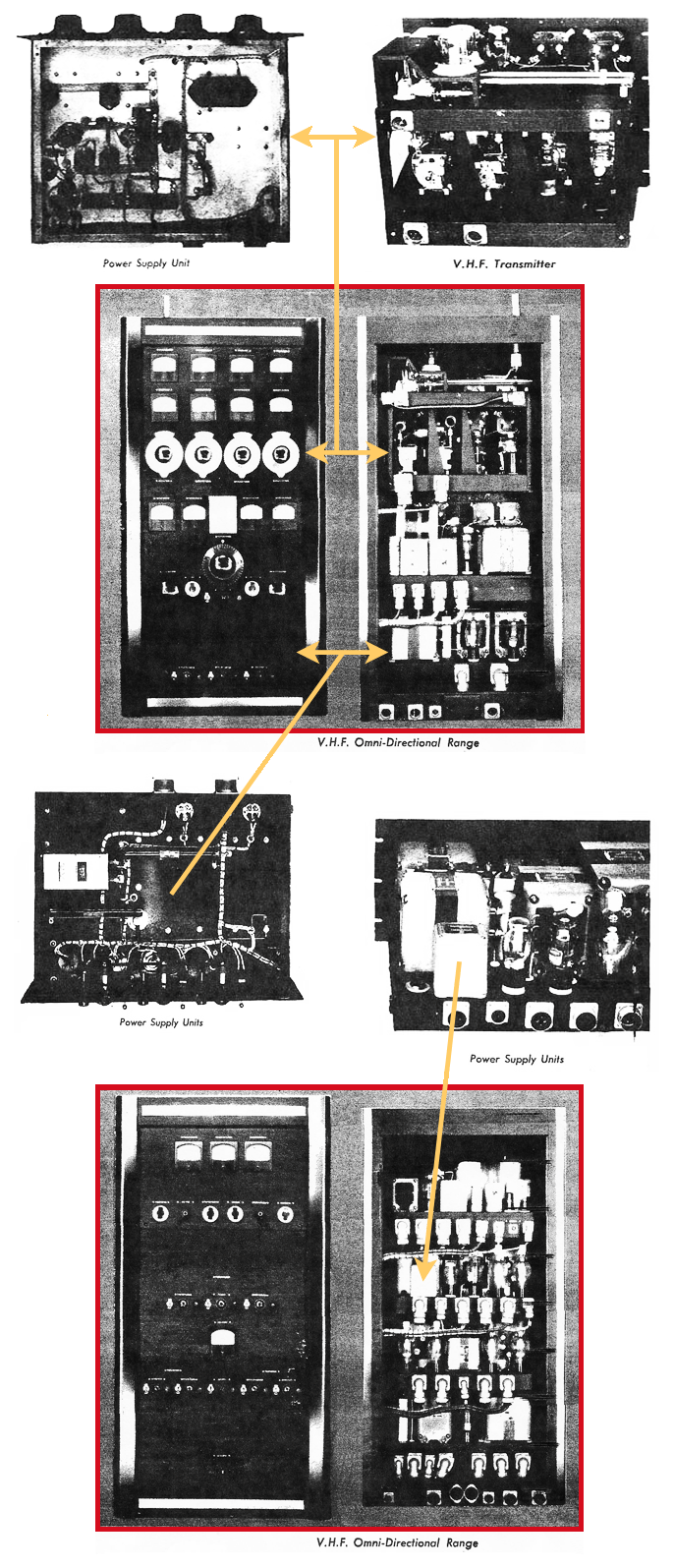The VHF Omni-Directional Range Components
Page 23 of the Argus 1945-46 progress report shows two sets of rack-mounted components identified as “VHF Omni-Directional Range.” These are not typical of the work that Argus did for Bendix and are not even devices that would have been used in military applications during WWII. The text beneath the illustration below outlines the questions these devices present and some history that may explain their presence in the Argus report.

The illustration above shows the two main components (red outlines) on page 23 of the Argus report, plus views of several components that appear on other pages of the report (but are clearly sub-components of the systems on page 23). Note that the labels for the two views of the topmost component are different: the left one is “Power Supply Unit” and the right one is “V. H. F. Transmitter.”
Page 23 of the 1945-1946 Argus Progress Report poses more questions than any other. It shows front and back views of two ground components of a “VHF Omni-Directional Range” (VOR) navigation system. Before VOR systems, navigators and pilots would determine their angular position from a ground station by searching for the direction of its maximum signal strength using a rotatable antenna. This process was dependent on human judgment and atmospheric and topological conditions, and sometimes resulted in significant errors.
VOR stations broadcast a rotating beam that changed phase as it rotated. A second signal carried the station’s ID and a zero degree (“north”) reference phase. A receiver on the aircraft compared these two phases and output the aircraft’s angular position from the ground station. No human direction-finding was necessary.
The two components shown on page 23 stand out from those in the rest of the report in a couple ways. They are large, complete, ground-based systems rather than the airborne sub-components typical of Argus’s Bendix contracts. Secondly, they are not components for military application - VOR systems were used only by American civilian aircraft until long after WWII.
The date of the Argus report is also a perplexing matter. According to a 1970 IEEE article [1], the Civil Aeronautical Administration initiated development of VOR systems in 1938. The article goes on to say that this work was delayed by WWII, and that a dual station experimental system (between New York and Chicago) was not evaluated until 1946. Only a handful of VOR systems were in place until well after 1950.
So the components shown in the Argus report date to well before VOR systems were in regular production, and must therefore be experimental or prototype devices. If so, what agency or lab were they made for? Where were they finally installed?
The IEEE article includes a description of the development of VOR that may contribute to the answers to these questions. It says that a contract was let by the Civil Aeronautical Administration to the Washington Institute of Technology in College Park, Maryland to develop a VOR system. Further, it says that the equipment for this system was not delivered to the CAA until 1944. These bits of history are consistent with both the date and the content of page 23 of the Argus report.
The Washington Institute of Technology was a small consulting and electronic design company specializing in aviation navigation, usually under government contract. It was composed of a handful of scientists and engineers, and had little or no production capacity. Bendix Radio, 40 miles away in Baltimore, would have been a logical local source for this capacity. It seems possible that WIT approached Bendix, and Bendix took the work and sub-contracted it to Argus, or that Bendix simply put WIT in touch with Argus. Of course, there may be no connection at all between WIT’s VOR system and Argus or Bendix.
Resolving this conjecture and the larger question of the customer and application for the VOR components in the Argus progress report is one of the main objectives of these web pages. Inputs, observations, or suggestions addressing this matter are welcome at the email address below.
Mike Reitsma and Pam Buckley
reitsma.mike@gmail.com
March 2015
[1] William E. Jackson (Ed.) The Federal Airways System, copyright 1970 The Institute of Electrical and Electronic Engineers, p235.